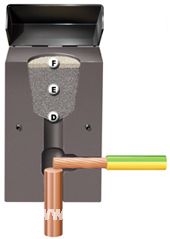产品类别
铜导线与垂直接地棒焊接过程
Making a CADWELD joint is a simple procedure as illustrated below:
 1 Locate the conductors (A)
1 Locate the conductors (A)
to be joined in the weld
cavity (B) and close
the mould (C).
 2 Locate the steel retaining disc in
2 Locate the steel retaining disc in
the base of the crucible (D). Pour
in the weld powder (E) followed
by the starting powder (F).
Ignite starting powder
with a spark gun.
 3 The resulting exothermic reaction
3 The resulting exothermic reaction
reduces the weld powder to molten
copper alloy which melts the
retaining disc and flows into
the weld cavity where it partially
melts the conductors (G).

4 The molten copper alloy cools
to leave a fusion weld of great
mechanical and electrical integrity.
CADWELD Moulds
The CADWELD system of exothermic welding uses moulds to contain the exothermic reaction that creates safe and robust connections. Different types of moulds are available, whose use depends on the requirements of the project.
Graphite Moulds
Market leading CADWELD graphite moulds are extremely robust and capable of producing over 75 connections each.
Mini-Moulds
CADWELD mini-moulds are a cost effective alternative to full-sized moulds, especially where lower numbers of connections are required. They are smaller overall, less robust and therefore lower priced. Care is required in order to achieve similar service lives to full-sized moulds.
SureSHOT
The CADWELD SureSHOT system is a single-use ceramic mould supplied complete with retaining disc and powders. It has been designed for use in applications where only a few connections are required. For more information CLICK HERE
| 上一篇:机房防静电接地及等电位连接下一篇:常见的放热焊接形式(火泥熔接) |













 豫公网安备41019702003907号
豫公网安备41019702003907号